A great idea to explore Hannover on your own is the Red Thread of Hannover. If you take a stroll through the old town and not only look at the buildings, but also give the street a glance, you will quickly come across a red line.
The Red Thread stretches over 4.2 km through the city and leads past the 36 most important sights. Each place is marked with a number in a circle, and to ensure that the Red Thread of Hannover is always easy to see, it is repainted every year.

The actual starting point is the Tourist Information (opposite the main station on Ernst-August-Platz), where you can also get a small booklet with the most important information. Of course, you can also start your city tour at a different point. The Red Thread of Hannover is a circular route that has its last point, the 36th point, at the equestrian monument of Ernst-August in front of the main railway station. Within sight is the Tourist Information with point 1.
Route points: Red Thread of Hannover
We went on a discovery tour along the Red Thread of Hannover.

1. Tourist information
The starting point of the Rote Faden von Hannover discovery tour with the big 1 on the pavement is in front of the Tourist Information.
2. Galerie Luise
The Galerie Luise invites you to a little shopping trip right at the beginning of your city exploration. The “Luise” opened in 1987 and for many Hannoverians a stroll under the glass roof is simply part of a visit to the city centre.
3. Opera
The opera house was built in 1845-1852 on the edge of the old town in the middle of a meadow. At that time it was still called the “Königliches Hoftheater” (Royal Court Theatre) and hosted opera and drama performances. Today, ballet and concerts are offered in addition to operas.

The house was built in late classicist style by the architect Georg Ludwig Laves, by whom many more buildings can be found in the city.
Unfortunately, like so many other buildings in Hannover, the Opera House did not survive the Second World War unscathed. During an attack, the building was hit by incendiary bombs and burned to the ground.
The reconstruction in the historical style was completed at the end of November 1950 with the opera performance of “Der Rosenkavalier.”
4. Georgstraße
Georgenstraße is named in honour of King George III. From the opera house you can walk to Aegidientorplatz. You will pass the GOP on the way. Today a variety theatre, famous personalities such as Marlene Dietrich and Josephine Baker once performed here.

One should not miss a look at the impressive memorial commemorating the persecution and deportation of Jews during the Nazi era. The memorial impressed me not only because of the interesting design by the Italian artist Michelangelo Pistoletto. For me, the view of the memorial changed once again when I discovered the numerous inscriptions of names, dates and places that can be read on the memorial.
Directly next to it are three older statues that form a complete contrast to the modern memorial. They depict Louis Strohmeyer, Karl Karmarsch and Heinrich Marschner, all of whom had something to do with Hanover and became famous in their respective fields of activity.
5. Georgsplatz
Arriving at Georgenplatz, the first thing that catches the eye is the French late Gothic building, which is now used by a bank.
6. Aegidientor
The Aegidientor was a city gate in Hannover’s old city wall. It was demolished in 1748 when the Aegidienneustadt was built. So there is not much to see here today. However, if you stand at this major traffic junction, you will see a stepped gable house from 1873 in Breite Straße. This was the site of a coffee roasting plant and “Ernst Grote Kaffee” was known far beyond the city’s borders for many years.
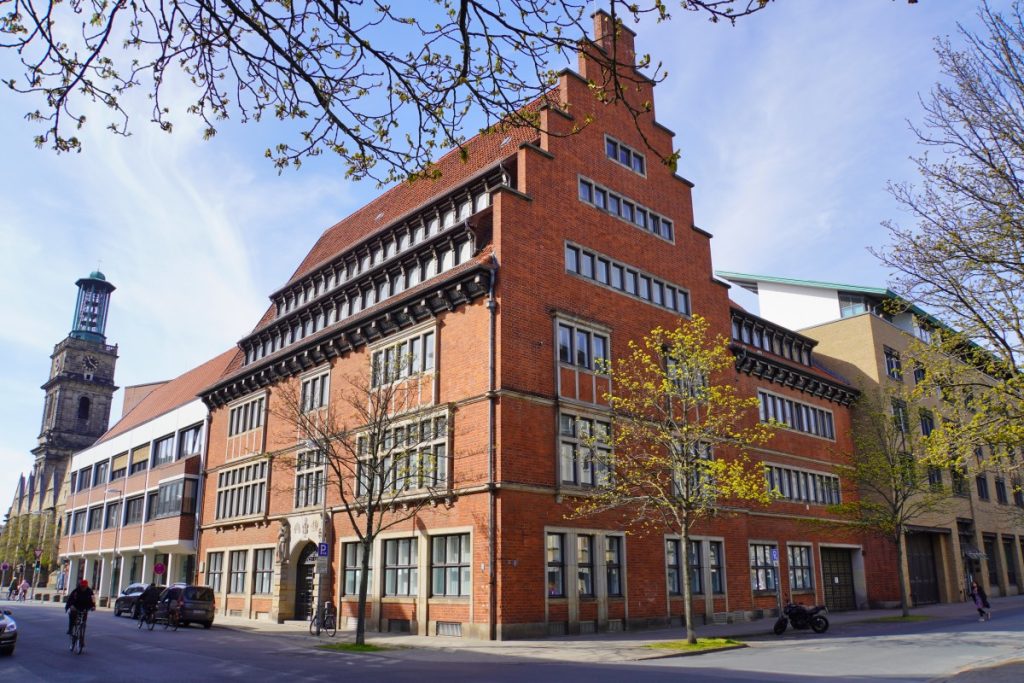
7. The Aegidien Church
The Aegidien Church in Hannover was built in the 14th century. It is named after Saint Ägidius. The three-nave Gothic hall church was built of sandstone and remodelled several times over the years. Air raids during the Second World War destroyed the church. It has not been rebuilt to this day and now stands as a memorial to the victims of war and violence in the city.

You can enter the church ruins free of charge during opening hours. Some works of art, such as the sculpture “Humility”, can be found in the nave.
If you can make it, try to be there in time to hear the chimes. A steel construction with a carillon was placed on the tower stump in 1958. 25 bronze bells are struck with magnetic hammers and played on a keyboard. Different songs are played daily at 9:05 am, 12:05 pm, 3:05 pm and 6:05 pm. The time is deliberately chosen so as not to sound at the same time as the bells of the neighbouring churches.

The Peace Bell, donated by Hiroshima in 1985, hangs in the tower entrance. It is struck every year on 6 August during a memorial service for the victims of the atomic bombing of Hiroshima.

Opening hours:
daily 10-18 h
8. Spartan Stone
The Spartan Stone is actually called the Seven Men’s Stone and is located on the outside of the Aegidien Church. It is found on the south-eastern outer wall on a supporting pillar.

On the relief plate you can see seven praying men, these are Hannover’s Spartans. According to legend, they are men who sacrificed themselves for the city in the Döhren Tower during a Guelph raid in 1490.
The original of the stone is in the Historisches Museum Hannover.
9. Gallery KUBUS
The next point on Hannover’s Red Thread invites you to make a longer stop. The KUBUS Municipal Gallery regularly hosts changing exhibitions. The focus is on artists from the Hannover region and the worldwide twin cities.
10. The Archer
Following the arrow on the pavement, you cross a large busy street. Even though your gaze immediately falls on the New Town Hall, point number 10 is the archer in front of the Town Hall.

The bronze statue is a copy of an Italian sculpture that stands in Munich. It is one of the most popular photo motifs in the city. Yes, and if you follow the arrowhead with your eyes, you know where the mayor is based.

11. The New Town Hall
Big, insanely impressive and almost like a castle, that was my first thought when I looked at Hannover’s New Town Hall.

Built in 1913 in the style of historicism and, as the then city manager was pleased to report, also paid for in cash, the New Town Hall is today Hannover’s landmark. The construction of the building was anything but easy. The ground here is extremely marshy and 6026 beech piles had to be driven into the ground in order to erect the building on them. The building still rests on these piles today.

You should definitely plan a walk around the building, even if the Red Thread path does not lead here. There are some photo spots worth seeing, great reflections in the water and beautiful lighting in the evening hours.

The dome, which can be visited at certain times, is particularly impressive. An arched lift rises at an angle of 17 degrees to a 43-metre-high viewing platform. Unfortunately, we were not lucky and the ascent was not possible during our visit. Or was it luck, because this way we will definitely visit the interesting city again to enjoy the view from the tower?
In any case, you can enter Hannover’s New Town Hall free of charge and look around the large entrance hall. What a hall! 38 metres high and impressive. My gaze was almost only focused on the snail-like staircases at the corners of the entrance hall. A large, wide, grandiose staircase leads from the hall to the upper floors. Here, the association with a castle immediately came back to me.
In the middle of the hall are four large city models of Hannover, which depict the city’s development very well. The first model depicts Hannover around 1689. The old town centre, which at that time was only allowed to be inhabited by Protestants, can be seen very clearly. People of other denominations had to live outside the old town. The second model shows Hannover on the same scale in 1939. At that time, about 470,000 people lived in the city.


The third model shows Hannover in 1945. I have never seen such an impressive model of a city. It shows the city after over 1.5 million bombs destroyed over 90% of the city in the Second World War. The city model shows this destruction and the little that was left very impressively. The last model shows Hannover as it exists today.
12. Museum August Kestner
Right next to the town hall is the House of 5000 Windows. The museum was being renovated when we visited and we could only see part of the exhibition.

However, we were not drawn to the museum because of the exhibitions of ancient and Egyptian cultures, design and a valuable collection of coins and medals. We wanted to see an architectural feature. A new museum building has been erected around the façade of the old museum building from 1889. It looks like a cube, consists of concrete latticework and 5000 windows. The old classicist façade is protected inside and can be visited.

Of course, we also took a tour of the areas of the exhibition that were open to the public. I was particularly impressed by the mummies and sarcophagi in the Egyptian collection and the easily understandable scientific explanations.
13. The Coat of Arms Portal
We almost overlooked it – the Guelph coat of arms hangs on a rather inconspicuous façade. A lion and a unicorn, which is the symbol for Scotland, hold a coat of arms. This is divided into 4 sections, which with their symbols illustrate the connection of the Guelphs to Ireland, England, Scotland, possessions in Franconia, Brunswick and Lüneburg.

14. The Laveshaus
Georg Ludwig Laves was a court architect and created numerous buildings in Hannover. The Laveshaus was created for him and his family and survived the Second World War unscathed.
15. The Wangenheim Palace
The Wangenheim Palace was created by the court architect Laves as a residence for Count Georg von Wangenheim. Later, King George V lived there.
16. The Waterloo Column
The Victory Goddess Victoria stands high atop the Waterloo Column. The column commemorates the Battle of Waterloo on 18 June 1815, in which the Hannoverians won together with the Prussians and the British against Napoleon.
17. Water art
A short walk along the Leine and the Leineschloss. Here is the spot where the Leine, which flows partly underground, emerges. For many years there was a neo-Gothic river water art there, but today only a relief reminds us of it.
18. The Leineschloss Bridge
The Leineschloss Bridge was built in 1686 according to the plans of an Italian master builder. It was possible to cross the Leine here and walk through the castle.

19. Hohe Ufer
The Hohe Ufer runs parallel to the Leine and is now a popular promenade. A settlement probably existed here as early as the 10th century. Henry the Lion held a court meeting in the settlement on the Hohe Ufer and later granted the town town charter.

20. The Nanas
Next to the New Town Hall, the Nanas are among the most popular photo motifs in Hannover. The artist Niki de Saint Phalle created the three rather buxom and feminine ladies who have been standing on the banks of the Leine since 1974.

They are affectionately called Sophie, Charlotte and Caroline. The namesakes were the famous Hannoverian electress Sophie (wife of Ernst August), Charlotte Buff (childhood sweetheart of Goethe) and Caroline Herschel (astronomer).
21. The old town
If you stroll through the old town and follow the Red Thread of Hannover, you will discover the many beautiful half-timbered houses. What you wouldn’t suspect is that here, too, not one stone was left upon another after the war. The houses were rebuilt and the half-timbered facades from the 16th and 17th centuries were placed in front of them. The result is a beautiful old town area.

22. The oldest town house
The next destination is the oldest town house in Hannover. The front house dates from 1566, the back house is two years older. After looking at the beautifully decorated façade, we could take a look through the open front door into the small courtyard and the back house. So I would move in there immediately.
23. Kreuzkirche
The Kreuzkirche (consecrated in 1333) stands in the secluded Kreuzkirche quarter in the old town. It is one of the city’s main sights.
Guided tours are offered regularly and at some times it is also possible to climb the tower. There is an altarpiece by Lucas Cranach the Elder in the nave.
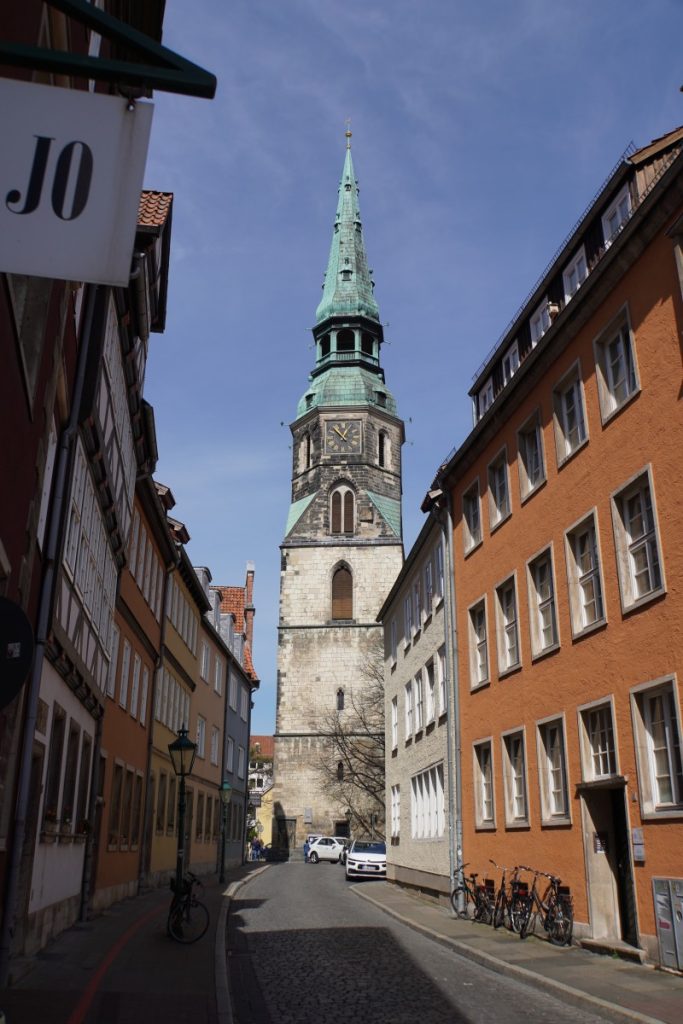
24. The Duve Chapel
On the south side of the church is the Duve Chapel. The entrepreneur Johann Duve was not only a Hannoverian, he also owned a huge business empire. When lightning destroyed the spire of the Kreuzkirche, he donated 100 thalers to rebuild it, but he earned 3000 thalers rebuilding the spire. In return for his donation, he received the right to build a family tomb. In addition, he had a weather vane in the shape of a dove (duve) installed.
Duve’s sons and a lost loan ruined the entrepreneur and he had to go bankrupt.
25. The Ballhof
Ballhofplatz is the location of the Ballhof, a theatre that belongs to the Lower Saxony State Theatre in Hannover. For me, Ballhofplatz is one of the most beautiful places in the city and I have to admit that I didn’t really notice the theatre as such.
Duke Georg Wilhelm had the Ballhof building constructed in 1649-1664. As the name suggests, parties and balls were to be celebrated here. But the Ballhof was also used for playing badminton and was thus also a sports hall. Playing badminton is said to have been a popular pastime for high society at the time.
26. The Historical Museum
The Red Thread of Hannover led us further through the city to the Historical Museum. Here you can find out about life in Hannover over the last four centuries.
27. Leine Castle
The castle was built around 1637. It stands directly on the Leine and we had already discovered the back during the tour along the Leine. From 1837 to 1866, the castle was the residence of the kings of Hannover.

Only the portico survived the Second World War unscathed, the rest of the castle was destroyed. The castle was rebuilt between 1956 and 1962 and has housed the Lower Saxony Parliament since 1992.

28. Leibnizhaus
Who doesn’t know him – Gottfried Wilhelm Leibnitz. No, not the inventor of the world-famous biscuit. He is only the namesake for this one, he never ate it. Leibnitz was a Hannoverian, philosopher, mathematician, physicist, lawyer and linguist/historian. The house where he lived and died has been rebuilt on Holzmarkt. Today it is a modern conference centre.

29. Kramerstraße
The tour of Hannover continues along Kramerstraße, one of the city’s most popular shopping streets. If you direct your gaze to the pavement, you will notice a cross in front of the corner house at Kramerstraße 25. From there you can see the four towers of the inner-city churches.
30. The Marktkirche (Market Church)
The Marktkirche stands in the heart of the old town. It was built in the 14th century in the style of North German brick Gothic. When we took a closer look at the church, we quickly agreed that the tower was a bit too small. It seems too compact for the church building. In the meantime, I know that a much higher tower was planned. Unfortunately, the city coffers ran out of money at the time, so they simply put a spire on the shortened tower. When the Marktkirche was rebuilt after the Second World War, the height of the tower was not changed.

I found the design of the church portal very interesting. The church doors, designed by the sculptor Gerhard Marcks, are truly unique. The reliefs depicted there show motifs with the saddest chapters of German history.
31. The Old Town Hall
Whoever has a New Town Hall usually also has an Old Town Hall. This is also the case in Hannover. The Old Town Hall was built in the brick Gothic style from 1410. It took almost 100 years to complete and at first the city fathers could only use a smaller two-storey angular building. The town hall was then gradually extended with annexes, such as the apothecary wing, which housed the council pharmacy. In 1844, the city planned to demolish the building, but fortunately this was prevented.

Today, the Old Town Hall is the seat of the registry office.
32. The head of envy
The envy head is a walled-in grimace. It is located on the courthouse arbour at the Old Town Hall. It is believed that the envious head was meant to ward off evil spirits.

33. The market hall
Hannoverians affectionately call the market hall the “belly of Hanover”. Rather uninviting from the outside, the market hall is a colourful and lively hive of activity. In addition to numerous “normal” market stalls, you can eat and drink well here. And if you really want to buy biscuits, there is a factory outlet in the market hall.

In front of the market hall is a statue of a market woman. According to legend, newlyweds should rub the neck of the bottle, the bread and the purse of the little woman so that they always have water, bread and money in the house.

34. The City
The tour along Hannover’s Red Thread is slowly coming to an end. A walk along one of the first and largest pedestrian zones in Germany follows.
35. Kröpcke
The Kröpcke is not only a central square in the pedestrian zone. There is also the Kröpcke Clock and the Kröpcke Café.
The Kröpcke Café is a long-established institution in the city. It opened as Café Robby in 1869 and was leased by Wilhelm Kröpcke in 1876. At its peak, the outdoor area had 2000 seats.
The Kröpcke clock is one of the meeting places that Hannoverians like to choose. In the past, in the time without mobile phones, you could always find a piece of paper and a pen there to leave a message. Today, the “belly” of the clock is a small museum. Changing exhibitions are shown here.
36. The Ernst August Monument
We have arrived at the last point of our “Red Thread of Hannover” tour. The Ernst August Monument stands in front of Hannover’s main railway station. In his hussar uniform, the first Hannoverian king Ernst August I is sitting on his horse.
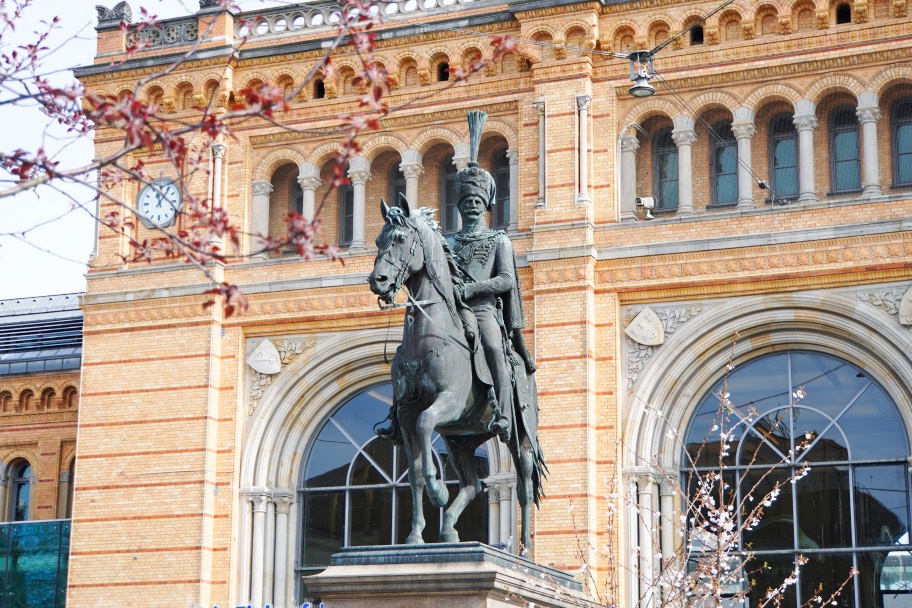
Under the tail of the monument is the second meeting place that Hannoverians like to choose.

Tip: You can also discover the city in Szczecin by following the Red Route!
The Red Thread of Hannover was an item on the programme of a research trip to Hannover.







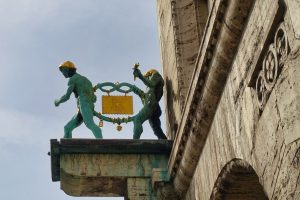





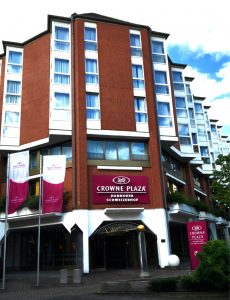
Leave a Reply